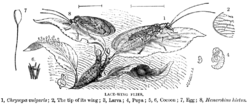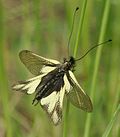The insect order Neuroptera, or net-winged insects, includes the lacewings, mantidflies, antlions, and their relatives (the group that was once known as the Planipennia). The order contains some 4000 species. Traditionally, the order also included alderflies, fishflies, dobsonflies, and snakeflies, but these are now generally considered to be separate orders (the Megaloptera and Raphidioptera). Sometimes the name Neuropteroidea (syn. Neuropterida)& is used to refer to these three orders as a group.
The adults of this order possess four membranous wings, with the forewings and hindwings about the same size, and with many veins. They have chewing mouthparts, and undergo complete metamorphosis.
Neuropterans first appeared during the Permian Period, and continued to diversify through the Mesozoic Era.& During this time several unusually large forms evolved, especially in the extinct family Kalligrammatidae, often referred to as "the butterflies of the Jurassic" due to their large, patterened wings.&
Life cycle and ecology
The larvae of most families are predators. Many chrysopids eat aphids and other pest insects, and have been used for biological control (either from commercial distributors but also abundant and widespread in nature). Larvae in various families cover themselves in debris (sometimes including dead prey insects) as camouflage, taken to an extreme in the ant lions, which bury themselves completely out of sight and ambush prey from "pits" in the soil. Larvae of some Ithonidae are root feeders, and larvae of Sisyridae are aquatic, and feed on freshwater sponges. A few mantispids are parasites of spider egg sacs.
As in other holometabolic orders, there is a pupal stage, generally enclosed in some form of cocoon composed of silk and soil or other debris. Adults of many groups are also predatory, but some do not feed, or consume only nectar.
Taxonomy
Template:Userboxtop Template:Clade
- Superfamily Coniopterygoidea
- Family Coniopterygidae: dustywings
- Superfamily Ithonioidea
- Family Ithonidae: moth lacewings (often includes "Rapismatidae")
- Superfamily Hemerobioidea
- Family Chrysopidae: green lacewings, stinkflies
- Family Dilaridae: pleasing lacewings
- Family Hemerobiidae: brown lacewings
- Family Polystoechotidae: giant Lacewings
- Family Psychopsidae
- Superfamily Osmyloidea
- Family Osmylidae
- Family Neurorthidae
- Family Sisyridae: spongillaflies
- Superfamily Mantispoidea
- Family Berothidae: beaded lacewings
- Family Mantispidae: mantidflies
- Superfamily Myrmeleontoidea
- Family Palaeoleontidae&
- Family Ascalaphidae: ascalaphids, owlflies
- Family Myrmeleontidae: ant-lions
- Family Nemopteridae: spoonwings
- Family Nymphidae
References
- ↑ http://mail.bio.pu.ru/win/entomol/KLUGE/nom/Neuropteroidea.htm
- ↑ Ponomarenko, A.G. and Shcherbakov, D.E. (2004). "New Lacewings (Neuroptera) from the Terminal Permian and Basal Triassic of Siberia." Paleontological Journal, 38(S2): S197-S203.[1]
- ↑ Engel, M.S. (2005). "A remarkable kalligrammatid lacewing from the Upper Jurassic of Kazakhstan (Neuroptera: kalligrammatidae)." Transactions of the Kansas Academy of Science, 108(1): 59-62.
- ↑ Oswald, John D. 1995. Neuroptera. Lacewings, antlions, owlflies, etc. [2]
- ↑ Palaeontology48:1409
- Grimaldi, D. and Engel, M.S. (2005). Evolution of the Insects. Cambridge University Press. ISBN 0-521-82149-5.
External links
- Ameisenjungfer.jpg
Euroleon nostras, an ant-lion
Template:Wikispecies Template:Wikibookspar
ca:Neuròpter cs:Síťokřídlí de:Netzflügler et:Võrktiivalised es:Neuroptera fa:بالتوریها fr:Neuroptera ko:풀잠자리목 hsb:Sytkokřidłač it:Neuroptera he:מרושתי כנף ka:ბადეფრთიანები lt:Tinklasparniai hu:Igazi recésszárnyúak nl:Netvleugeligen ja:アミメカゲロウ目 no:Nettvinger pl:Sieciarki pt:Neuroptera sl:Pravi mrežekrilci sv:Nätvingar zh:脈翅目



